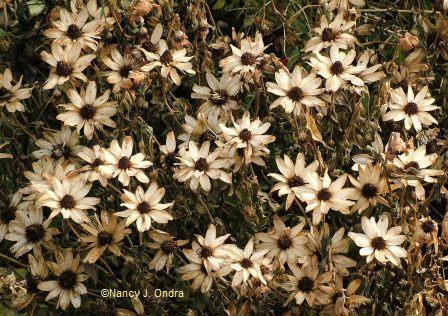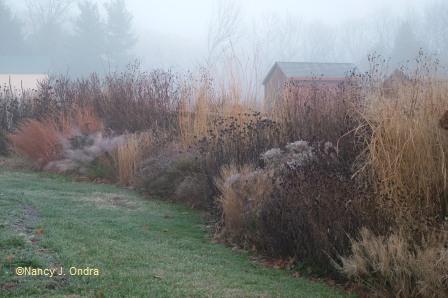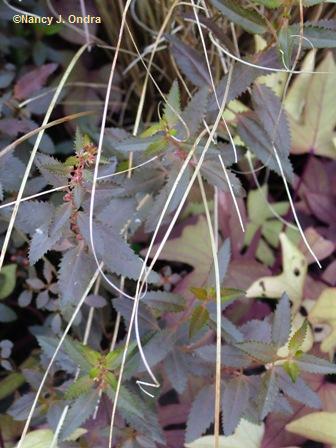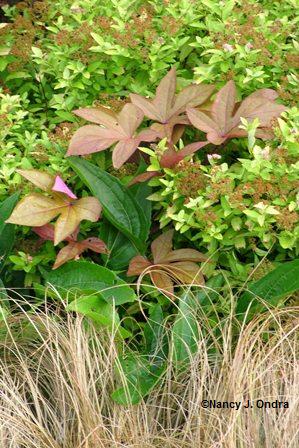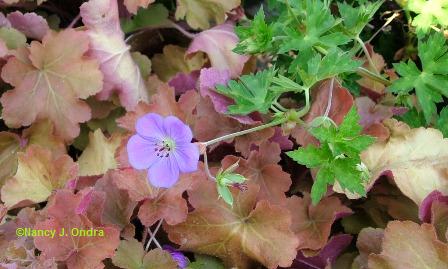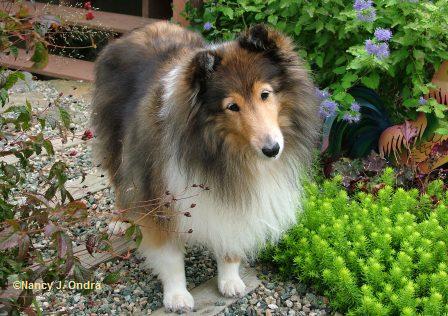Text and photographs ©Nancy J. Ondra 2008
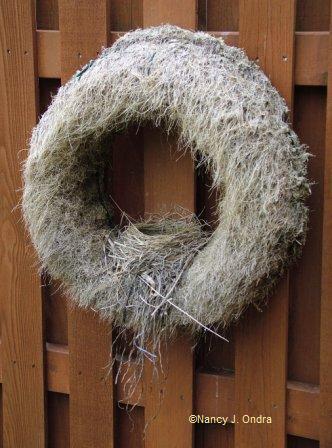 The point of this month’s Garden Blogger’s Design Workshop is to indulge in some sumptuous color at a time when many of us don’t have much to celebrate in our outdoor gardens. But when you consider that browns are such a big part of our surroudings for a good four to five months every year, it’s easy to see that being able to find beauty in brown can be an invaluable coping technique. Without the distraction of “ooh, pretty colors!”, it’s much easier to notice more subtle details, such as contrasting forms and textures. Enjoying winter browns also provides an excellent excuse for holding off on garden cleanup. For instance, I was pleasantly surprised to see how well the blooms of ‘Profusion Cherry’ zinnia held up post-frost, long after they lost their rich pinkness.
The point of this month’s Garden Blogger’s Design Workshop is to indulge in some sumptuous color at a time when many of us don’t have much to celebrate in our outdoor gardens. But when you consider that browns are such a big part of our surroudings for a good four to five months every year, it’s easy to see that being able to find beauty in brown can be an invaluable coping technique. Without the distraction of “ooh, pretty colors!”, it’s much easier to notice more subtle details, such as contrasting forms and textures. Enjoying winter browns also provides an excellent excuse for holding off on garden cleanup. For instance, I was pleasantly surprised to see how well the blooms of ‘Profusion Cherry’ zinnia held up post-frost, long after they lost their rich pinkness.
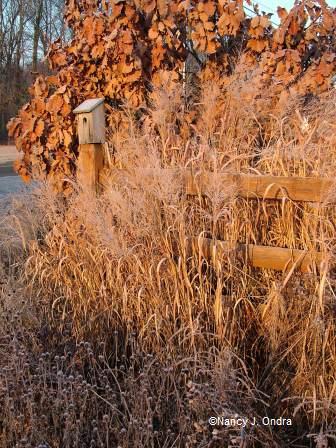 The lingering stalks of warm-season ornamental grasses and perennial seedheads are a great place to start when trying to embrace winter brownness. At left is one of my favorite vignettes all year long. The fence and bluebird box provide permanent structure, while the Rudbeckia fulgida var. fulgida in the front adds rich green foliage, bright blooms, and long-lasting seedheads as the seasons change. In the middle is ‘Dallas Blues’ switch grass (Panicum virgatum), which is a beauty in leaf, in bloom, and in skeletal form as well. At the back is Japanese emperor oak (Quercus dentata), which holds its dried leaves well into spring. That used to annoy me, and I’d pick them off individually. But now, the tree is way too big for that to be practical, so I gradually learned to tolerate them, and now I’m *almost* sorry to see them go when the tree decides to sprout anew.
The lingering stalks of warm-season ornamental grasses and perennial seedheads are a great place to start when trying to embrace winter brownness. At left is one of my favorite vignettes all year long. The fence and bluebird box provide permanent structure, while the Rudbeckia fulgida var. fulgida in the front adds rich green foliage, bright blooms, and long-lasting seedheads as the seasons change. In the middle is ‘Dallas Blues’ switch grass (Panicum virgatum), which is a beauty in leaf, in bloom, and in skeletal form as well. At the back is Japanese emperor oak (Quercus dentata), which holds its dried leaves well into spring. That used to annoy me, and I’d pick them off individually. But now, the tree is way too big for that to be practical, so I gradually learned to tolerate them, and now I’m *almost* sorry to see them go when the tree decides to sprout anew.
Around the corner from the oak is another lesson in my self-study course of Brown Appreciation. It was my first attempt in creating a border based on contasting plant and flower forms, rather than on color, and the summer and fall effect exceeded my expectations. Its beauty in winter, though, which I hadn’t even thought about at planning time, was an absolute revelation. Granted, on clear, bright winter days, it looks very much like a bunch of crispy, dead stalks. But in the softer light of misty mornings and dreary afternoons, the range of bleach-blonds to tans to coppers and near-blacks makes an almost eerie echo of the summer lushness.
Once you start appreciating the subtle beauties of browns, it’s a short step to tolerating them, if not positively enjoying them, during the growing season too. A while back, I wrote Brown-y Points, about some of my favorite brown-leaved plants, but I’ll mention them here again, because I think they’re neat. Below left, the rich brown of Haloragis erecta ‘Wellington Bronze’ with paler Carex buchananii; below right, ‘Sweet Caroline Bronze’ sweet potato vine (Ipomoea batatas) with Carex ‘Toffee Twist’ and the tan seedheads of ‘Gold Mound’ spirea. See, when you use brown foliage in a combination, you can claim it as a color echo for the dead bits of its partners, so it actually reduces garden maintenance chores. (Yeah, right, Nan.)
The newer heucheras also offer some out-of-the-ordinary colors, several of which can fall into the brown category. A lot depends on the amount of light they get, and the time of year, of course, but many of these have some pinkish tones too. Brown and blue definitely isn’t a combination I’d create on purpose, but – in this instance, anyway – there was enough pink in both Heuchera villosa ‘Caramel’ and Geranium Rozanne to create an interesting pairing.
Still not sure how you feel about summer browns? Consider trying a few in a pot first. That way, you can move them around to experiment with different combinations or hide them if non-gardening company is coming. (Why do you have that pot of dead plants sitting there, anyway?) Or, consider a self-propelled color swatch. I tried this one, though I must admit that it wasn’t a particularly helpful design tool, because it looked lovely with pretty much anything, anywhere, anytime.


